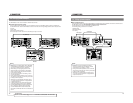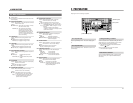
6
1-3 Precautions
Handling
5
Do not block the ventilation openings.
5
Do not place anything heavy on the unit.
5
Do not put any foreign materials into the cassette
loading slot.
5
Operate the unit in a horizontal (flat) position only.
5
Avoid violent shocks to the unit.
Transportation
5
Remove the cassette tape from the unit prior to trans-
portation.
Energy saving
5
When not using the unit, turn the power off to avoid
unnecessary power consumption.
1 INTRODUCTION
Cassette tape
5
Type
Only cassettes bearing the MiniDV mark can be used
with this VCR.
5
Handling
• Cassette tapes cannot be loaded upside-down.
• Rewind the tape to the beginning before storage.
• The number of times a tape can be reused is limited.
If the tape is reused more than this, increased noise
(such as dropouts) may result. Do not use dirty or
damaged tapes. Doing so not only results in poorer
performance, but may also shorten the service life of
the rotary heads.
• It is possible that some distortion may occur at the
beginning and end of tapes. This can vary depending
on the tape. However, for best results, do not use
these sections of the tape for any important
recordings.
Erasure prevention
MiniDV cassettes are provided with a safety slide on the
side to prevent accidental erasure. Set it as required.
Installation and storage
5
Avoid using the unit in places subject to the following
conditions:
– Extreme heat or cold
– Strong magnetic field
– High humidity
– Dust and soil
– Vibrations
– Condensation
Condensation
5
Do not use this unit immediately after moving it from a
cold place to a warm place or after switching on a heater
in a cold room. This will cause water vapor to condense
on the video head drum and tape guides and may
damage the tape and the VCR.
5
When condensation occurs, the DEW indication appears
on the tape counter display and the warning indication
on the on-screen display. Leave the VCR in this state
with the power on and wait until the warning message
turns off.
Head drum
Video tape
Safety slide
R
E
C
S
A
V
E
• Move the slide to SAVE to prevent erasure.
• Move the slide to REC to allow recording.
Power supply
5
This unit is provided with both AC and DC power
supplies. For editing over an extended period, it is
recommended that you use a stable AC power supply or
DC power supply from an AC adapter. Using battery
power is recommended only as a supplementary power
source or for field use.
5
The AC and DC power supplies are switched automati-
cally. When the AC power supply is switched to the DC
power supply, the power turns off. When both power
supplies are connected, the AC power supply has
priority. Be sure to confirm which power supply is in use
when plugging or unplugging the power supply.
7
2 CONTROLS, CONNECTORS AND DISPLAYS
2-1 Front Panel
PHONES
MIC
REMOTE
LOCAL
EJECT
OPERATE
REC LEVEL
CH-2/4
CH-1/3
SHIFT
SET
SELECT
SHIFT
MENU
HOLD
AUDIO
MONITOR OUTPUT COUNTER
SHIFT A. DUB
ADVANCE PRESET
L CTL
TC
UB
CH-1/2
CH-3/4
R
MIX MIX
REW STOP FF
REC PLAY
PAUSE
ON/OFF
MENU
OVER
OVER
HMSF
AUD LOCK
SP
32k 48k
SLAVE PB NDF
SERVORF
DEW
AUTO OFF
HOLD
CH 2/4
CH 1/3
VIDEO CASSETTE RECORDER BR-DV600U
dB40 30 20 10
0
[OPERATE] switch
Press this switch to turn this unit ON. Press it again to
turn this unit OFF. When the power is OFF, the “oPE-oFF”
indication is shown.
Keep in mind that a small amount of current continues
to flow into the VCR even when the power is turned
off. When not using this unit, disconnect the power
cable from the AC outlet. Remove the battery when
not in use to avoid excessive discharge.
[EJECT] button
Press to eject the cassette.
[REMOTE/LOCAL] switch
Use to switch between REMOTE and LOCAL.
[MIC] jack
Connect a microphone (3.5 mm dia., –67 dBs, 3 kΩ).
Operation buttons
Use to control tape running.
REC: Recording
PLAY: Playback
PAUSE: Temporary stop
REW: Rewinding
STOP: Stop
FF: Fast-forwarding
LCD Display
Use to show various data including the tape counter and au-
dio level meter. For details, refer to
“LCD display” on page
10.
[COUNTER] switch
Use to switch the type of data displayed on the tape
counter. When the No. 516 <DISPLAY SELECT> menu
switch is set to “CLOCK”, clock is shown for
TC and
date is shown for UB.
[AUDIO OUTPUT] switch
Use to select the audio channel to output from the rear
panel’s [AUDIO OUT] connectors and the headphones.
[AUDIO MONITOR] switch
Use to select the audio channel to output from the rear panel
’
s
[AUDIO MONITOR OUT] connectors.
[PHONES] jack
Connect a set of headphones (3.5 mm dia. mini-jack).
PHONES control
Use to adjust the volume level of the headphones
connected to the PHONES jack.
[REC LEVEL] control
Use to adjust the audio recording level.
CH-1/3: CH1 can be adjusted in normal recording.
CH3 recording level can be adjusted in audio
dubbing.
CH-2/4: CH2 can be adjusted in normal recording.
CH4 recording level can be adjusted in audio
dubbing.
Audio dubbing is possible when the No. 245 <SAM-
PLING RATE> menu switch is set to
“32K”.
Setting buttons
Use to set the menu switch, time code and user bits.
Menu switch setting
MENU: Press to set the menu switch setting mode.
SHIFT +/–: Use to select the menu switch.
SET: Use to enter the set value.
SELECT: Use to change the value.
Time code and user bits setting
HOLD: Press to set the time code, user bits or time
date setting mode.
SHIFT: Use to select the digit whose value is to be
changed.
ADVANCE:Use to change the value.
While pressing the [SHIFT] button, press this
button to reset the set data to
“0”.
PRESET: Use to enter the changed value and end setting.
Use as a counter reset button when the
[COUNTER] switch is set to
“CTL”.
[AUDIO DUB] button
Use to perform audio dubbing when the No. 245
<SAMPLING RATE> menu switch is set to
“32K”.
Cassette loading slot
Load and unload a cassette.


















